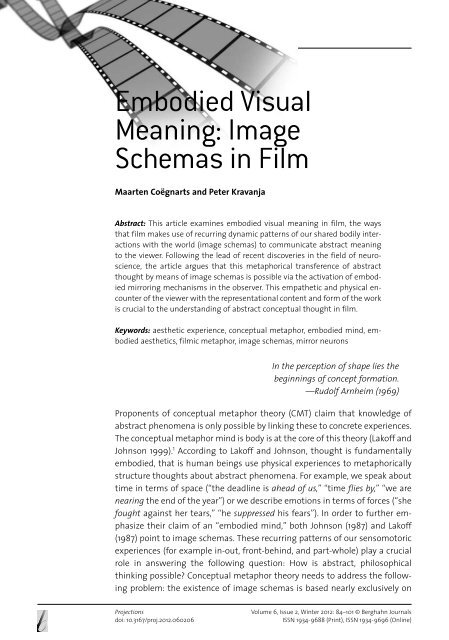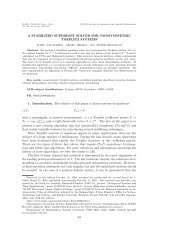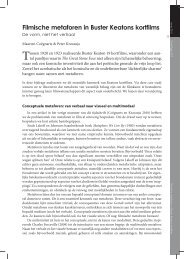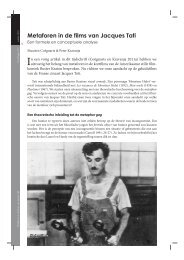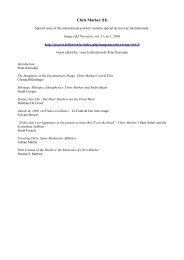Embodied Visual Meaning: Image Schemas in Film - Peter Kravanja
Embodied Visual Meaning: Image Schemas in Film - Peter Kravanja
Embodied Visual Meaning: Image Schemas in Film - Peter Kravanja
You also want an ePaper? Increase the reach of your titles
YUMPU automatically turns print PDFs into web optimized ePapers that Google loves.
E M B O D I E D V I S U A L M E A N I N G / 8 9understand abstract schemas (for a discussion of causation, If image schemas aresee, e.g., Johnson 2008), then the former cannot act as a substitutefor the latter.metaphorically recruitedto understand abstractFurthermore, Buckland seems to suggest that all schemasand all metaphors derive from the body and not from the world schemas then the formeroutside of our bodies. Adopt<strong>in</strong>g this perspective neglects, however,the importance of culture (Kövecses 2005; Yu 1998,) and for the latter.can not act as a substitutehistory (Blumenberg 1998) <strong>in</strong> characteriz<strong>in</strong>g metaphor andschemas. As Westra (2010: 128) argues by referr<strong>in</strong>g to Blumenberg’s metaphorology,we should avoid the temptation to reduce all metaphor to thesphere of embodiment: “Both approaches (embodiment and the cultural/historicaldimension) can, and even should be, viewed as complementary for anoverall theory of metaphor.”In this article we propose, then, to adopt a moderate view of imageschemas. Rather than reject<strong>in</strong>g Bordwell’s theory, we argue that both viewscan be complimentary. <strong>Image</strong> schema theory does not have to rule out a moreabstract account of schemas. Follow<strong>in</strong>g Buckland (2000), although not <strong>in</strong> anabsolute way, and some other recent studies (Branigan 2003, 2006; Forceville2011; Forceville and Jeul<strong>in</strong>k 2011; Kappelhoff and Müller 2011) we plead for a renewedappreciation of the body by consider<strong>in</strong>g Lakoff and Johnson’s notion ofimage schemas <strong>in</strong> the light of the filmic medium. Whereas Buckland (2000:46–51) tries to determ<strong>in</strong>e how a specific schema can be applied to generalconcepts from film theory such as frame or diegesis, we opt to illustrate theprocess of embodied mean<strong>in</strong>g by show<strong>in</strong>g some of the ways <strong>in</strong> which imageschemas operate <strong>in</strong> significant film scenes. In what follows we describe fiveimage schemas <strong>in</strong> film, and we show how they determ<strong>in</strong>eThe same image schema canthe structure of abstract conceptual thought. In discuss<strong>in</strong>geach image schema, we sometimes refer to l<strong>in</strong>guistic examples.This, however, does not imply that l<strong>in</strong>guistic language. Both media areoperate <strong>in</strong> film as well as <strong>in</strong>metaphors are needed for the viewer <strong>in</strong> order to grasp the manifestations of one and themean<strong>in</strong>g of the scene <strong>in</strong> question. By br<strong>in</strong>g<strong>in</strong>g them <strong>in</strong>, wesame conceptual metaphor.only want to draw attention to CMT’s claim that metaphoris primarily conceptual, a matter of thought. Therefore, the same imageschema can operate <strong>in</strong> film as well as <strong>in</strong> language. Both media are manifestationsof one and the same conceptual metaphor.Conta<strong>in</strong>er This schema is essential to our physical experience and is characterizedby the attributes <strong>in</strong>side, border, and outside. Concern<strong>in</strong>g themetaphorical application, Lakoff and Johnson (1980: 30) note that the visualfield is generally perceived as a conta<strong>in</strong>er, as th<strong>in</strong>gs appear <strong>in</strong> and out of view(“there is noth<strong>in</strong>g <strong>in</strong> view,” “she is out of sight,” “I can’t see him because thattree is <strong>in</strong> the way”). A complex filmic application of this image schema is of-
9 0 / P R O J E C T I O N SFigures 1–2.Spartacus: Theconta<strong>in</strong>er imageschemafered by a scene from Spartacus (1960). The film shows Julius Caesar (JohnGav<strong>in</strong>) <strong>in</strong> a Roman bath while he is convers<strong>in</strong>g with patrician and strategistMarcus Lic<strong>in</strong>ius Crassus (Laurence Olivier). The men are opposite each otherand depicted without <strong>in</strong>terference of cutt<strong>in</strong>g. Crassus fills the left side of thefilmic space, Caesar the right. Crassus has decided to manipulate Caesar <strong>in</strong> orderto get rid of his political opponent <strong>in</strong> the Senate, the hedonist SemproniusGracchus (Charles Laughton). When later on Gracchus jo<strong>in</strong>s the conversation,the mise-en-scène is adjusted. Caesar moves toward the neutral center of thescreen, flanked by the two sides between which he will have to choose (Figure1). Then Crassus leaves the scene, empty<strong>in</strong>g the filmic space he was occupy<strong>in</strong>g.Caesar then rises and puts himself opposite Gracchus, thus occupy<strong>in</strong>gthe same space (or conta<strong>in</strong>er) that was <strong>in</strong>habited by Crassus (Figure 2). Wherehis position had been neutral before, he has now chosen a side. This change<strong>in</strong> the state of affairs is confirmed by a play with shot-reverse shots. Bothmen no longer fill the same filmic space (conta<strong>in</strong>er). As such, the concrete (<strong>in</strong>this case our shared physical experience of <strong>in</strong> and out) is metaphoricallyextended and used to express the abstract political mach<strong>in</strong>ations of the corruptRoman aristocrats. In other words, the image schema of a conta<strong>in</strong>er functionsas a solution to the problem of how to express political power strugglesc<strong>in</strong>ematically. 4
E M B O D I E D V I S U A L M E A N I N G / 9 1SOURCE-PATH-GOAL In their study on the SPG schema <strong>in</strong> animation, Forcevilleand Jeul<strong>in</strong>k (2011) show how this image schema plays a crucial role <strong>in</strong> conceptualiz<strong>in</strong>gtime. In the short animation film O (1996), for example, the SPGschema is <strong>in</strong>stantiated by movement from right (past, birth) to left (future,death), thus spatially suggest<strong>in</strong>g the protagonist’s matur<strong>in</strong>g and age<strong>in</strong>g. Butlive action films make use of this schema as well. In a scene from Professione:Reporter (1975), the images betray the use of the SPG schema to solve thefilmic problem of a flashback. When foreign correspondent David Locke (JackNicholson) switches his identity for deceased weapons dealer Robertson’s(Charles Mulvehill), the film goes back <strong>in</strong> time to a conversation between thetwo men. This flashback occurs as follows: the camera moves un<strong>in</strong>terruptedly<strong>in</strong> a horizontal way from an <strong>in</strong>itial condition A (the present: Locke at the tablewhile he trades his passport photo for Robertson’s) over a pathway C to dest<strong>in</strong>ationB (the past: both men talk<strong>in</strong>g on the veranda) and then returns from B(the past) to A (the present). As the movement takes place horizontally, theschema left-right is part of the metaphoric conveyance. The left side of theroom is temporally one with the past, the right corresponds to the present.Movement <strong>in</strong>to the depth of the screen would turn the schema <strong>in</strong>to front-beh<strong>in</strong>d.Th<strong>in</strong>k, for example, of the open<strong>in</strong>g scene from Murder, My Sweet (1944).As this time-mov<strong>in</strong>g metaphor (see also Gentner and Imai 1992; Lakoff andJohnson [1980] 2003) depends on a filmic parameter (<strong>in</strong> this case: the movementof the camera), it can be called a filmic metaphor, follow<strong>in</strong>g Rohd<strong>in</strong>(2009).Center-Periphery This image schema f<strong>in</strong>ds its physical roots <strong>in</strong> the experienceof the body as center and <strong>in</strong> that of the perceptual field as periphery. It can bedescribed briefly as follows: a perceived object ga<strong>in</strong>s <strong>in</strong>tensity as it approachesthe center (see also Deane 1995: 633). The shorter the distance to the center,the greater the potential for <strong>in</strong>teraction and <strong>in</strong>timacy, and vice versa. In theAmerican war film Casualties of War (1989), deal<strong>in</strong>g with the abduction andrape of a Vietnamese teenage girl by four American soldiers, this imageschema is used to metaphorically emphasize Sgt Meserve’s (Sean Penn) dom<strong>in</strong>antposition with<strong>in</strong> his group of soldiers. The film shows a static shot of SgtMeserve <strong>in</strong> the foreground while he is shav<strong>in</strong>g. His four subjects are <strong>in</strong> thebackground. The image is constructed symmetrically, visually accentuat<strong>in</strong>gthe vertical axis <strong>in</strong> the middle. This separation is given emphasis <strong>in</strong> the antefilmicspace by the presence of a hang<strong>in</strong>g blanket <strong>in</strong> the middle of the screen,separat<strong>in</strong>g the two entities. Sgt Meserve is stand<strong>in</strong>g to the right of the blanketwhile the soldiers can be seen to its left. The <strong>in</strong>formation with<strong>in</strong> this frameis more or less constant. Neither the camera nor the characters move <strong>in</strong> anyway that calls attention to itself, keep<strong>in</strong>g the structure of the image stable.The shot makes use of the split-focus technique (keep<strong>in</strong>g the foreground and
9 2 / P R O J E C T I O N Sthe background <strong>in</strong>to focus at the same time), suggest<strong>in</strong>g that the film deliberatelychooses to keep as short a distance as possible between Sgt Meserveand the camera. As the leader of the group, he is centralized, while his soldiersrema<strong>in</strong> <strong>in</strong> the periphery. Because of this, he ga<strong>in</strong>s <strong>in</strong>tensity and his dom<strong>in</strong>antposition is suggested to the viewer. As such, the positional terms front andback are laden with abstract mean<strong>in</strong>g <strong>in</strong> this context. On top of that, the sergeantis shown to the right of the screen, not the left. As the viewer’s gazeseems to be drawn to the right when read<strong>in</strong>g an image <strong>in</strong> a static frame, thecharacter <strong>in</strong> the right of the frame is always given more attention than thescene <strong>in</strong> the left (Gross and Bomste<strong>in</strong> 1978). This discovery from perceptualpsychology is used metaphorically to motivate Sgt Meserve’s position with<strong>in</strong>the frame.Verticality The schema vertically or high-low/top-down f<strong>in</strong>ds its physical roots<strong>in</strong> numerous experiences. As a rule, people tend to lie down while sleep<strong>in</strong>gand get up when wak<strong>in</strong>g up. Happ<strong>in</strong>ess and sadness are often metaphoricallyunderstood <strong>in</strong> terms of this schema (“I fell <strong>in</strong>to a depression,” “the moralesank,” “my joy was ris<strong>in</strong>g”). Control and submission are also articulated throughthis schema. Earlier we discussed how the image schema center-peripheryserved to answer the psychological (and as such, abstract) control exercised bySgt Meserve <strong>in</strong> Casualties of War. Another scene from the same film showshow the vertically image schema can play the same role as a possible filmic alternative.In one shot, the film shows Sgt Meserve <strong>in</strong> worm’s-eye view (lowangle) while the object of his gaze (the soldiers) is filmed <strong>in</strong> bird’s-eye view(high angle). The effect of this subjective style of shoot<strong>in</strong>g is that of Sgt Meservelook<strong>in</strong>g down on his subjects like a div<strong>in</strong>e figure. The spatial terms lowand high receive the connotations of submission and control, respectively. Thisway, the film evokes the conceptual metaphor control is high, be<strong>in</strong>g submittedto control is low (see also Lakoff and Johnson [1980] 2003: 15). In this example,we are deal<strong>in</strong>g with a filmic metaphor where the camera angle is responsiblefor evok<strong>in</strong>g the conceptual metaphor <strong>in</strong> the viewer. Besides the angle, filmmakerscould choose to make use of the antefilmic space as well. For example,American director Joseph Losey is known to use the vertical dynamic of thestairs metaphorically <strong>in</strong> order to represent the dialectic between master andslave and the correspond<strong>in</strong>g relationship of the dom<strong>in</strong>eer<strong>in</strong>g and the submissive(examples can be seen <strong>in</strong> The Servant [1963] and Accident [1967]).Balance F<strong>in</strong>ally, the balance image schema f<strong>in</strong>ds its roots <strong>in</strong> the physical experienceof the symmetrical distribution of gravitational forces relat<strong>in</strong>g to acentral axis, such as the balance exercised by a rope dancer. In his book TheBody <strong>in</strong> the M<strong>in</strong>d: The Bodily Basis of <strong>Mean<strong>in</strong>g</strong>, Imag<strong>in</strong>ation, and Reason, MarkJohnson (1987) describes how the physical experience of balance metaphori-
E M B O D I E D V I S U A L M E A N I N G / 9 3cally relates to the visual content of art. This image schema would expla<strong>in</strong>why the perception of symmetry is often experienced as pleasant, as the contentof the art seems to metaphorically imitate the physical experience of balanceand symmetry.However, the image schema can also be used to express oppositions on ahigher and more abstract level. An example of this can be found <strong>in</strong> You OnlyLive Once (1937). In this fatalistic drama of doom directed by Fritz Lang, HenryFonda plays ex-convict Eddie Taylor who cannot seem to f<strong>in</strong>d a steady job <strong>in</strong>the outside world. He marries Joan Graham (Sylvia Sidney) and the couple hasa child. When Taylor is wrongfully accused of murder, he runs away. In his attemptto escape from the police, Taylor ultimately commits an actual murder,which leads to a grim and untimely death for himself and his beloved. In orderto express a dy<strong>in</strong>g faith <strong>in</strong> modern society (represented <strong>in</strong> the film by <strong>in</strong>stitutionssuch as the Church, the judicial system and prison), on the onehand, and the unity of love, on the other, the film makes clever use of the balanceimage schema. The first part of the film has the camera show<strong>in</strong>g Taylor<strong>in</strong> the presence of his priest and his attorney. He is allowed to leave prison. Thethree characters walk toward the exit of the prison, which serves as a gatewayto his beloved. The walk<strong>in</strong>g action is filmed with a lateral travel<strong>in</strong>g shot, follow<strong>in</strong>gthe characters toward the exit. The scene is filmed <strong>in</strong> a strik<strong>in</strong>g way.The camera bobs up and down, partially cutt<strong>in</strong>g off Fonda’s face <strong>in</strong> the topedge of the screen (Figure 3). When the metal gate is opened, the situationchanges. Another travel<strong>in</strong>g movement is used, this time a very pure and precisemovement straight toward Joan (Figure 4). This way the film restores asense of security to the images that was lack<strong>in</strong>g before. When Eddie sees Joan,balance is returned. She gives him the certa<strong>in</strong>ty that he is mov<strong>in</strong>g <strong>in</strong> the rightdirection. The deliberately erratic movements of the image, <strong>in</strong>side and outside,represented his sense of unease and the possibility of th<strong>in</strong>gs go<strong>in</strong>gFigures 3–4. YouOnly Live Once: Thebalance imageschema
9 4 / P R O J E C T I O N Swrong aga<strong>in</strong>, an omen of the doom that awaits later <strong>in</strong> the film. It is alsoworth not<strong>in</strong>g that the couple is shown <strong>in</strong> the center of the screen when theyare renewed. The only source of security is not the Church or the judicial system,but love. This idea is communicated metaphorically us<strong>in</strong>g the imageschema of balance. 5<strong>Image</strong> <strong>Schemas</strong> and the Viewer: On Mirror Neuronsand Aesthetic ExperienceSo far we have restricted ourselves to a discussion concern<strong>in</strong>g image schemason the level of specific filmic images. Now the follow<strong>in</strong>g question arises: howdo these image schemas relate to the viewer? How is the (physical) viewer related,for example, to the (embodied) SPG schema from Professione: Reporter?This question is crucial because the film maker has the <strong>in</strong>tention to transferabstract content. This primarily requires the viewer to relate to the embodiedaspects of the image schemas on screen—whether this occurs consciously ornot. The body functions as a conduit for abstract conceptual thought. Withoutthis conformity between object and subject, no transference can takeplace.The recent discovery of “mirror neurons” with<strong>in</strong> the doma<strong>in</strong> of neuroscience(Gallese et al. 1996; Rizzolatti et al. 1996) offers a possible answer tothe question of how this bridge can be made. These neurons, considered bysome to be one of the most important discoveries <strong>in</strong> modern bra<strong>in</strong> science,are spread over crucial parts of our bra<strong>in</strong>: the premotor cortex and posteriorparietal cortex. The remarkable quality of the mirror neuron system (MNS) isthat it not only activates when we perform a certa<strong>in</strong> action, but also when wesee another person perform<strong>in</strong>g that same action. When the MNS is activated,the observation of an action triggers the same neural networks that are activedur<strong>in</strong>g its execution (Freedberg and Gallese 2007: 200). They are called mirrorneurons because the visual characteristics of the neurons (the visual stimuliactivat<strong>in</strong>g the neurons dur<strong>in</strong>g the passive act of watch<strong>in</strong>g) reflect the motoricactivity (the motoric actions neurons activate when perform<strong>in</strong>g the action <strong>in</strong>question). The discovery of this mechanism suggests that, when we see anotherperson perform<strong>in</strong>g an action, we are mentally perform<strong>in</strong>g the same action.In short, this means that each action we witness, we repeat <strong>in</strong> our m<strong>in</strong>ds,whether it is Buster Keaton’s acrobatics or the ambiguous smile on Liv Ullmann’sface <strong>in</strong> Ingmar Bergman’s Persona (1966). On a more fundamentallevel, this means that there is probably a biological dynamic that supports ourunderstand<strong>in</strong>g of others and the complex exchange of abstract ideas.Recogniz<strong>in</strong>g the implications of the discovery of mirror<strong>in</strong>g mechanisms forour understand<strong>in</strong>g of art, Freedberg and Gallese (2007) and Gallese (2010,2011) have been among the first to apply this model from neuroscience to aestheticexperience. In their study, they describe the aesthetic experience as pri-
E M B O D I E D V I S U A L M E A N I N G / 9 5marily a physical encounter of the viewer with the artwork where the work—whether it be a static work such as a build<strong>in</strong>g or a pa<strong>in</strong>t<strong>in</strong>g, or mov<strong>in</strong>g art suchas film or dance—activates all k<strong>in</strong>ds of mechanisms <strong>in</strong> the viewer <strong>in</strong>clud<strong>in</strong>gthe simulation of actions, emotions, and tactile sensations. This discovery of aphysical relation between object and subject as a basis for aesthetic experienceis not new. In 1873 Robert Vischer (1994) already <strong>in</strong>troduced the conceptof empathy or E<strong>in</strong>fühlung <strong>in</strong> the doma<strong>in</strong> of aesthetics. Vischer described E<strong>in</strong>fühlungas the physical response caused by the form with<strong>in</strong> a pa<strong>in</strong>t<strong>in</strong>g. 6 Accord<strong>in</strong>gto him, symbolic shapes get their mean<strong>in</strong>gs primarily from theirembodied and anthropomorphic content. What is new <strong>in</strong> Freedberg andGallese is the connection of this notion of empathy to mirror neurons. Assuch, they br<strong>in</strong>g the discussion on the aesthetic role of empathy from a metaphysicaland <strong>in</strong>tuitive level to a material and physical level (the def<strong>in</strong>ablestructure of the body and the bra<strong>in</strong>). Mirror neurons therefore form an empiricaland objective basis for the role of empathy and emotion <strong>in</strong> the aestheticexperience of the viewer. Suddenly, empathy is given a more important rolethan it has traditionally been endowed by art historians such as E. H. Gombrich(1960) and R. H. Coll<strong>in</strong>gwood (1938) whose focus was on the cognitive aspectsof art. As such, the concepts of empathy and emotion are freed fromtheir position of isolation and neglect.Freedberg and Gallese’s (2007) theory on empathy is expressed throughtwo complementary aspects of relations. First, there is the “relation betweenembodied empathetic feel<strong>in</strong>gs <strong>in</strong> the observer and the representational contentof the works <strong>in</strong> terms of the actions, <strong>in</strong>tentions, objects, emotions andsensations depicted <strong>in</strong> a given pa<strong>in</strong>t<strong>in</strong>g or sculpture” (ibid.: 199). This aspectcan be described as the what of the aesthetic experience. Second, there is the“relation between embodied, empathetic feel<strong>in</strong>gs <strong>in</strong> the observer and thequality of the work <strong>in</strong> terms of the visible traces of the artist’s creative gestures,such as vigorous modell<strong>in</strong>g <strong>in</strong> clay or pa<strong>in</strong>t, fast brushwork and signs ofthe movement of the hand more generally” (ibid.). This aspect is the how ofthe aesthetic experience and refers more generally to the form of the artwork.In this case the sense of the felt bodily response arises not from any seen actions,but from the implied movement of the artist. Th<strong>in</strong>k for example of thegrandiose strokes of <strong>Peter</strong> Paul Rubens or of Jackson Pollock’s action pa<strong>in</strong>t<strong>in</strong>g.Although Freedberg and Gallese mostly focus on pa<strong>in</strong>t<strong>in</strong>g, film can be recognizedto share these two sources of aesthetic experience. On the one hand,physical experiences can be evoked <strong>in</strong> the viewer by events and actionson the antefilmic level, that what is be<strong>in</strong>g depicted <strong>in</strong> front ofthe camera.On the other hand, the embodied mechanisms can be activated <strong>in</strong>the viewer by events on the filmic level. It is ma<strong>in</strong>ly <strong>in</strong> this categorythat the examples discussed above can be categorized. Th<strong>in</strong>k of Pro-The embodiedmechanisms can beactivated <strong>in</strong> theviewer by events onthe filmic level.
E M B O D I E D V I S U A L M E A N I N G / 9 7sory aspect. Tak<strong>in</strong>g these observations <strong>in</strong>to account, Freedberg and Gallese’sdualistic model can be extended to a three-part model (see Figure 6):Figure 6. Three-part model of aesthetic experienceConclusionIn his 1873 essay “Über das optische Formgefühl: E<strong>in</strong> Beträg zur Ästhetik,”Robert Vischer dist<strong>in</strong>guishes between Sehen and Schauen. The former he describesas the mere passive and unconscious experience of physiological stimuliwhere the stimuli received have not yet been transformed and ordered <strong>in</strong>toa mean<strong>in</strong>gful, liv<strong>in</strong>g whole. It is the task of the process of Schauen to achievethat transformation and order. Vischer typifies Schauen as follows:Scann<strong>in</strong>g (Schauen) is more conscious than mere see<strong>in</strong>g (Sehen), for itsets out to analyze the forms dialectically (by separat<strong>in</strong>g and reconnect<strong>in</strong>gthe elements) and to br<strong>in</strong>g them <strong>in</strong>to a mechanical relationship.Scann<strong>in</strong>g alone makes a complete artistic presentation possible, for itsmovement ...is accompanied by an impell<strong>in</strong>g animation of the deadphenomenon, a rhythmic enliven<strong>in</strong>g and revitalization of it....Once Ihave accomplished the process of scann<strong>in</strong>g, the impression of see<strong>in</strong>g isrepeated on a higher level. What I have seem<strong>in</strong>gly separated I have reassembled<strong>in</strong>to an ordered and restful unity. Aga<strong>in</strong> I have an enclosed,complete image, but one developed and filled with emotion. To chaotic“Be<strong>in</strong>g” I called “Become!” (1994: 94)This article has focused on the second form of view<strong>in</strong>g. We have shownhow filmic images are anchored <strong>in</strong> bodily experience via image schemas. Thisthesis is biologically and neurologically justified by the recent discovery ofmirror neurons, which may serve as an explanatory model for the empathicexchanges between object and subject. The result of this process is a k<strong>in</strong>d ofharmony between the viewer as a physical subject and the filmic images. Our
9 8 / P R O J E C T I O N Sanalysis of specific filmic images has allowed us to conclude that this conformitybetween the two can be applied metaphorically to convey abstractmean<strong>in</strong>g. <strong>Embodied</strong> image schemas such as conta<strong>in</strong>er, SPG schema, centerperiphery,, verticality, and balance are applied metaphorically <strong>in</strong> order to expressabstract phenomena such as power struggles, psychological conditions,and the movement of time. Therefore, our analysis allows us to appreciateboth the cognitive and the physical dimension of aesthetic experience. In thisway, our article offers a nuanced middle road between the purely cognitiveand the purely physical. Let us conclude by quot<strong>in</strong>g Warren Buckland (2000:51): “Perception is not a process that <strong>in</strong>volves a relation between the eye andthe m<strong>in</strong>d (whether conscious or unconscious); more fundamentally, it <strong>in</strong>volvesthe metaphorical projection of the body on screen and <strong>in</strong> frame.”Maarten Coëgnarts has an MA <strong>in</strong> <strong>Film</strong> Studies and <strong>Visual</strong> Culture from theUniversity of Antwerp and MA <strong>in</strong> Sociology from the University of Antwerp.His research primarily focuses on metaphor <strong>in</strong> film and embodied visualmean<strong>in</strong>g. He also has a special <strong>in</strong>terest <strong>in</strong> film analysis and <strong>in</strong> the relation betweenfilm and philosophy.<strong>Peter</strong> <strong>Kravanja</strong> holds MS and PhD <strong>in</strong> Mathematical Eng<strong>in</strong>eer<strong>in</strong>g and ComputerScience from the Katholieke Universiteit Leuven, MA <strong>in</strong> C<strong>in</strong>ema Studies fromthe Université de la Sorbonne Nouvelle—Paris 3, and BA <strong>in</strong> Philosophy fromthe Katholieke Universiteit Leuven. His research <strong>in</strong>terests <strong>in</strong>clude analytic philosophyof art applied to c<strong>in</strong>ema, filmic metaphors, questions concern<strong>in</strong>ganalysis, <strong>in</strong>terpretation, and form, as well as the relation between film and theother arts.
E M B O D I E D V I S U A L M E A N I N G / 9 9Notes1In cognitive or conceptual metaphor theory it is common to use small capital letters to<strong>in</strong>dicate that these particular word<strong>in</strong>gs are not a matter of language, but of concepts, belong<strong>in</strong>gto the realm of human thought. These concepts are underly<strong>in</strong>g the very nature ofour daily metaphorical expressions (l<strong>in</strong>guistic or otherwise).2Accord<strong>in</strong>g to Kant ([1781/1787] 1999), the schema—which he described as “an art hidden<strong>in</strong> the depths of the human soul”—was the third <strong>in</strong>stance allow<strong>in</strong>g the application ofpurely cognitive concepts (categories) on sensory experiences.3We refer to the dist<strong>in</strong>ction made by German philosopher Mart<strong>in</strong> Heidegger betweenVorhandense<strong>in</strong> and Zuhandense<strong>in</strong>. The former marks the relation between man and th<strong>in</strong>g asa conscious and theoretical one. The latter has its mean<strong>in</strong>g flow<strong>in</strong>g forth from the way werelate to all th<strong>in</strong>gs <strong>in</strong> our daily existence.4For a similar reflection on this scene—albeit not from a metaphorical angle—see Günther(2004).5These reflections are partly <strong>in</strong>spired by the <strong>in</strong>sights of French filmmaker ClaudeChabrol who analyzes a few scenes from the film <strong>in</strong> the short documentary Fritz Lang parClaude Chabrol (2003), which can be viewed as an extra feature on the Region 2 DVD of YouOnly Live Once (EAN: 5050582501704).6We refer to the observations on art theory made by Aby Warburg and Maurice Merleau-Ponty.See Rampley (1997) for a discussion by Aby Warburg relat<strong>in</strong>g to Robert Vischer.ReferencesArnheim, Rudolph. 1969. <strong>Visual</strong> Th<strong>in</strong>k<strong>in</strong>g. Berkeley and Los Angeles: University of CaliforniaPress.Blumenberg, Hans. 1998. Paradigmen zu e<strong>in</strong>er Metaphorologie. Frankfurt am Ma<strong>in</strong>: Suhrkamp.Bordwell, David. 1985. Narration <strong>in</strong> the Fiction <strong>Film</strong>. London: Routledge.Bordwell, David. 2008. Poetics of C<strong>in</strong>ema. New York: Routledge.Branigan, Edward. 2003. “How Frame L<strong>in</strong>es (and <strong>Film</strong> Theory) Figure.” Pp. 59–86 <strong>in</strong> <strong>Film</strong> Styleand Story: A Tribute to Torben Grodal, eds. Lennard Hojbjerg and <strong>Peter</strong> Schepelern.Copenhagen: Museum Tusculanum Press.Branigan, Edward. 2006. Project<strong>in</strong>g a Camera: Language-Games <strong>in</strong> <strong>Film</strong> Theory. New York:Routledge.Buckland, Warren. 2000. The Cognitive Semiotics of <strong>Film</strong>. Cambridge: Cambridge UniversityPress.Coll<strong>in</strong>gwood, Rob<strong>in</strong> George. 1938. The Pr<strong>in</strong>ciples of Art. London: Oxford University Press.Deane, Paul D. 1995. “Metaphors of Center and Periphery <strong>in</strong> Yeats’ The Second Com<strong>in</strong>g.” Journalof Pragmatics 24 (6): 627–642.Dodge, Ellen, and George Lakoff. 2005. “<strong>Image</strong> <strong>Schemas</strong>: From L<strong>in</strong>guistic Analysis to NeuralGround<strong>in</strong>g.” Pp. 57–91 <strong>in</strong> From Perception to <strong>Mean<strong>in</strong>g</strong>: <strong>Image</strong> <strong>Schemas</strong> <strong>in</strong> Cognitive L<strong>in</strong>guistics,ed. Beate Hampe. Berl<strong>in</strong>: Mouton de Gruyter.Forceville, Charles. 2009. “Non-verbal and Multimodal Metaphor <strong>in</strong> a Cognitivist Framework:Agendas for Research.” Pp. 19–42 <strong>in</strong> Multimodal Metaphor, eds. Charles Forcevilleand Eduardo Urios-Aparisi. Berl<strong>in</strong>: Mouton de Gruyter.Forceville, Charles. 2011. “The Journey Metaphor and the Source-Path-Goal Schema <strong>in</strong>Agnès Varda’s Autobiographical Glean<strong>in</strong>g Documentaries.” Pp. 281–297 <strong>in</strong> Beyond CognitiveMetaphor Theory: Perspectives on Literary Metaphor, ed. Monika Fludernik. London:Routledge.
1 0 0 / P R O J E C T I O N SForceville, Charles, and Marloes Jeul<strong>in</strong>k. 2011. “The Flesh and Blood of <strong>Embodied</strong> Understand<strong>in</strong>g:The Source-Path-Goal Schema <strong>in</strong> Animation <strong>Film</strong>.” Pragmatics & Cognition 19(1): 37–59.Freedberg, David, and Vittorio Gallese. 2007. “Motion, Emotion and Empathy <strong>in</strong> AestheticExperience.” Trends <strong>in</strong> Cognitive Sciences 11 (5): 197–203.Gallese, Vittorio. 2010. “Mirror Neurons and Art.” Pp. 441–449 <strong>in</strong> Art and the Senses, eds.Francesca Bacci and David Melcher. Oxford: Oxford University Press.Gallese, Vittorio. 2011. “See<strong>in</strong>g Art ...Beyond Vision. Liberated <strong>Embodied</strong> Simulation <strong>in</strong> AestheticExperience.” Pp. 62–65 <strong>in</strong> See<strong>in</strong>g with the Eyes Closed, eds. Alexander Abbushi,Ivana Franke and Ida Mommenejad. Berl<strong>in</strong>: Association of Neuroesthetics.Gallese, Vittorio, Luciano Fadiga, Leonardo Fogassi, and Giacomo Rizzolatti. 1996. “ActionRecognition <strong>in</strong> the Premotor Cortex.” Bra<strong>in</strong> 119 (2): 593–609.Gallese, Vittorio, and George Lakoff. 2005. “The Bra<strong>in</strong>’s Concepts: The Role of the Sensory-Motor System <strong>in</strong> Conceptual Knowledge.” Cognitive Neuropsychology 22 (3/4): 455–479.Gentner, Dedre, and Mutsumi Imai. 1992. “Is the Future Always Ahead? Evidence for System-Mapp<strong>in</strong>gs <strong>in</strong> Understand<strong>in</strong>g Space-Time Metaphors.” Pp. 510–515 <strong>in</strong> Proceed<strong>in</strong>gs of theFourteenth Annual Meet<strong>in</strong>g of the Cognitive Science Society. Bloom<strong>in</strong>gton, IN: Erlbaum.Gombrich, E. H. 1960. Art and Illusion: A Study <strong>in</strong> the Psychology of Pictorial Representation.London: Phaidon.Gross, Charles, and Marc Bornste<strong>in</strong>. 1978. “Left and Right <strong>in</strong> Science and Art.” Leonardo 1 (1):29–38.Günther, W<strong>in</strong>fried. 2004. “A Shot Conveys an Outlook: Some Aspects of Mise-en-scène <strong>in</strong>Spartacus.” Pp. 57–65 <strong>in</strong> K<strong>in</strong>ematograph: Stanley Kubrick, eds. Bernd Eichorn et al. FrankfurtAm Ma<strong>in</strong>: Deutsches <strong>Film</strong>museum.Hampe, Beate. 2005. “<strong>Image</strong> <strong>Schemas</strong> <strong>in</strong> Cognitive L<strong>in</strong>guistics: Introduction.” Pp. 1–12 <strong>in</strong>From Perception to <strong>Mean<strong>in</strong>g</strong>: <strong>Image</strong> <strong>Schemas</strong> <strong>in</strong> Cognitive L<strong>in</strong>guistics, ed. Beate Hampe.Berl<strong>in</strong>: Mouton de Gruyter.Johnson, Mark. 1987. The Body <strong>in</strong> the M<strong>in</strong>d: The Bodily Basis of <strong>Mean<strong>in</strong>g</strong>, Imag<strong>in</strong>ation, andReason. Chicago: University of Chicago Press.Johnson, Mark. 1993. Moral Imag<strong>in</strong>ation: Implications of Cognitive Science for Ethics. Chicago:University of Chicago Press.Johnson, Mark. 2005. “The Philosophical Significance of <strong>Image</strong> <strong>Schemas</strong>.” Pp. 15–33 <strong>in</strong>From Perception to <strong>Mean<strong>in</strong>g</strong>: <strong>Image</strong> <strong>Schemas</strong> <strong>in</strong> Cognitive L<strong>in</strong>guistics, ed. Beate Hampe.Berl<strong>in</strong>: Mouton de Gruyter.Johnson, Mark. 2007. The <strong>Mean<strong>in</strong>g</strong> of the Body: Aesthetics of Human Understand<strong>in</strong>g. Chicago:University of Chicago Press.Johnson, Mark. 2008. “Philosophy’s Debt to Metaphor.” Pp. 39–52 <strong>in</strong> The Cambridge Handbookof Metaphor and Thought, ed. Raymond W. Gibbs, Jr. New York: Cambridge UniversityPress.Kant,Immanuel. [1781/1787] 1999. Critique of Pure Reason. Cambridge: Cambridge UniversityPress.Kappelhoff, Herman, and Cornelia Müller. 2011. “<strong>Embodied</strong> <strong>Mean<strong>in</strong>g</strong> Construction: MultimodalMetaphor and Expressive Movement <strong>in</strong> Speech, Gesture, and Feature <strong>Film</strong>.”Metaphor and the Social World 1 (2): 121–153.Kövecses, Zoltán. 2005. Metaphor <strong>in</strong> Culture: Universality and Variation. Cambridge: CambridgeUniversity Press.Lakoff, George. 1987. Women, Fire and Dangerous Th<strong>in</strong>gs: What Our Categories Reveal Aboutthe M<strong>in</strong>d. Chicago: University of Chicago Press.
E M B O D I E D V I S U A L M E A N I N G / 1 0 1Lakoff, George, and Mark Johnson. [1980] 2003. Metaphors We Live By. Chicago: University ofChicago Press.Lakoff, George, and Mark Johnson. 1999. Philosophy <strong>in</strong> the Flesh: The <strong>Embodied</strong> M<strong>in</strong>d and itsChallenge to Western Thought. New York: Basic Books.Rampley, Matthew. 1997. “From Symbol to Allegory: Aby Warburg’s Theory of Art.” Art Bullet<strong>in</strong>79 (1): 41–55.Rizzolatti, Giacomo, Luciano Fadiga, Vittorio Gallese, and Leonardo Fogassi. 1996. “PremotorCortex and the Recognition of Motor Actions.” Cognitive Bra<strong>in</strong> Research 3 (2): 131–141.Rohd<strong>in</strong>, Maths. 2009. “Multimodal Metaphor <strong>in</strong> Classical <strong>Film</strong> Theory from the 1920s tothe 1850s.” Pp. 403–428 <strong>in</strong> Multimodal Metaphor, eds. Charles Forceville and EduardoUrios-Aparasi. Berl<strong>in</strong>: Mouton de Gruyter.Tomashevsky, Boris. 1965. “Thematics.” Pp. 61–95 <strong>in</strong> Russian Formalist Criticism: Four Essays,eds. Lee Lemon and Marion Reis. L<strong>in</strong>coln: University of Nebraska Press.Vischer, Robert. 1994. “On the Optical Sense of Form.” Pp. 89–123 <strong>in</strong> Empathy, Form andSpace: Problems <strong>in</strong> German Aesthetics, 1873–1893, trans. and eds. Harry Francis Mallgraveand Eleftherios Ikonomou. Santa Monica: Getty Center for the History of Art and theHumanities.Westra, Adam. 2010. “Review of Hans Blumenberg’s Paradigms for a Metaphorology.” Trans.Robert Savage. Ithaque 7 (1): 119–129.Yu,N<strong>in</strong>g. 1998. The Contemporary Theory of Metaphor: A Perspective from Ch<strong>in</strong>ese. Amsterdamand Philadelphia: Benjam<strong>in</strong>s.<strong>Film</strong>ographyAntonioni, Michelangelo. 1975. Professione: Reporter (The Passenger). Italy and Spa<strong>in</strong>.Bergman, Ingmar. 1966. Persona. Sweden.Clert, Vassili. 2003. Fritz Lang par Claude Chabrol. France.De Palma, Brian. 1989. Casualties of War. USA.Dmytryk, Edward. 1944. Murder, My Sweet. USA.Khurana, Kireet. 1996. “O”. India.Kubrick, Stanley. 1960. Spartacus. USA.Lang, Fritz. 1937. You Only Live Once. USA.Losey, Joseph. 1963. The Servant. UK.———. 1967. Accident. UK.


